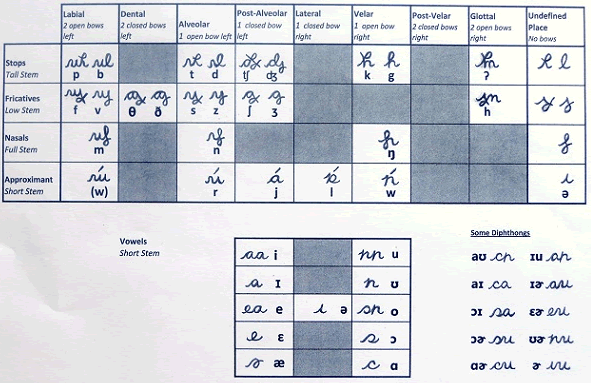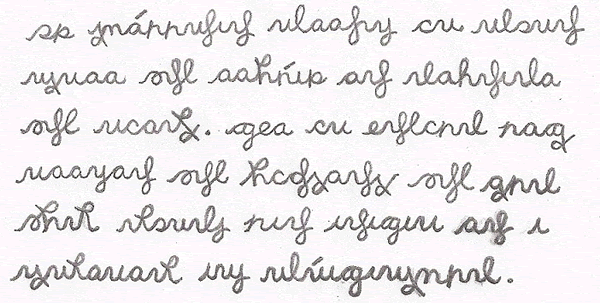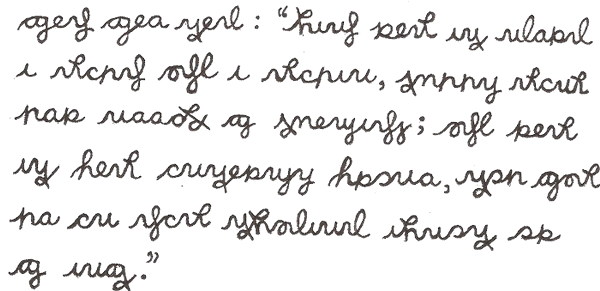Tengwarpt is a phonetic alphabet designed in 2006 by Sheldon Ebbeler, a linguist and analyst of verbal behavior. Tengwarpt is "featural", like Hangul, but only more systematically so. That is, distinctive features of the spoken sounds consistently correspond to distinct features of the written symbols. For example, any written symbol with one open "bow" to the left of the midline is an alveolar phoneme.
Tengwarpt was originally created to be a cursive version of Tolkien's Tengwar, also a featural alphabet. However, aside from surface similarities, the two paradigms are clearly very different systems. For example, Tengwarpt employs separate written segments to represent vowels-in line with the goal of a more fluid script-rather than the vowel diacritics found in Tolkien's Tengwar abjad. Another example is how pairs of written symbols for otherwise identical phonemes display voicing or lack thereof. With Tengwarpt, a crossing of the stem of the voiced consonant grapheme yields the unvoiced analogue. The version of Tengwarpt displayed here illustrates the phonemic inventory of standard English; however, since the paradigm is systematically featural, it can be easily extended to transcribe other languages' sounds.
There are 3 parts to any given Tengwarpt symbol: (1) the vertical stem, (2) closed or open bows to the left or right of the stem, and (3) the cursive crossing of the stem. These 3 components of the written symbols directly correspond to the spoken elements' distinctive feature categories (1) manner, (2) place, and (3) voicing respectively. (1) There are 4 types of vertical stems corresponding to 4 manners of production:
(2) There are 8 places represented by the closed and opened bows either to the left or right of the stem.
*Note: "Lateral" is traditionally considered a manner of production. Here it was convenient to alternatively imagine it as a place, corresponding to the sides of the tongue.
When these are displayed in full, you can see that the first four place representations (corresponding to the front places in the mouth) resemble the last four place representations (farther back in the mouth)-but upside-down and reflected through a mirror. The stem can be imagined as a vertical center line in the mouth such that the bows indicate how far, forward or backward, the given place is relative to this midline. This pattern facilitates learning how the bows correspond to the places of articulation.
It is worth noting that Tolkien envisioned different "modes" of the Tengwar system, corresponding to the different phonologies of different dialects or languages. As such, the Tengwar were later adapted to be able to write a number of other languages including French, Finnish, Esperanto, etc. The same could be done with the Tengwarpt paradigm. For example, if the Dravidian language Tamil were assigned a Tengwarpt mode, retroflex consonants would fit into the bow slot involving one closed bow to the left of the stem, pushing all the other places back.
If a manner is identified with an unspecified place (i.e, the stem is written without bows), such a symbol takes on the place of a preceding consonant. This is useful in quickly writing frequent sound combinations-like consonant clusters or affricate sounds-that share a common place (like [nd], [st], [tsh], [dz], etc.). Not surprisingly, a short stem with an unspecified place represents the schwa vowel.


All human beings are born free and equal in dignity and rights. They
are endowed with reason and conscience and should act towards one another
in a spirit of brotherhood.
(Article 1 of the Universal Declaration of Human Rights)

Then they said: "Come let us build a town and a tower, whose top will reach
the heavens; and let us get ourselves glory, so that we are not scattered across
all the earth."
Excerpt from Tower of Babel story
Funnish, Knot alphabet, Tengwarpt, Uriovakiro
Constructed scripts for: Ainu | Arabic | Chinese languages | Dutch | English | Hawaiian | Hungarian | Japanese | Korean | Lingala | Malay & Indonesian | Persian | Tagalog / Filipino | Russian | Sanskrit | Spanish | Taino | Turkish | Vietnamese | Welsh | Other natural languages | Colour-based scripts | Tactile scripts | Phonetic/universal scripts | Constructed scripts for constructed languages | Adaptations of existing alphabets | Fictional alphabets | Magical alphabets | A-Z index | How to submit a constructed script
Tengwar pages: Tengwar for Quenya, Sindarin, Arabic, English, Finnish, High Valyrian, Hungarian, Icelandic, Kurdish, Portugese, Russian, Scottish Gaelic (1), Scottish Gaelic (2), Spanish, Spanish (Latin American), Turkish, Vietnamese, Welsh
Tolkien's alphabets and languages: Cirth | Sarati | Tengwar for Quenya | Tengwar for Sindarin | Uruk Runes | Links | Books about Tolkien's languages | Tolkien's books
Constructed scripts for: Ainu | Arabic | Chinese languages | Dutch | English | Hawaiian | Hungarian | Japanese | Korean | Lingala | Malay & Indonesian | Persian | Tagalog / Filipino | Russian | Sanskrit | Spanish | Taino | Turkish | Vietnamese | Welsh | Other natural languages | Colour-based scripts | Tactile scripts | Phonetic/universal scripts | Constructed scripts for constructed languages | Adaptations of existing alphabets | Fictional alphabets | Magical alphabets | A-Z index | How to submit a constructed script
[top]
You can support this site by Buying Me A Coffee, and if you like what you see on this page, you can use the buttons below to share it with people you know.

If you like this site and find it useful, you can support it by making a donation via PayPal or Patreon, or by contributing in other ways. Omniglot is how I make my living.
Note: all links on this site to Amazon.com, Amazon.co.uk
and Amazon.fr
are affiliate links. This means I earn a commission if you click on any of them and buy something. So by clicking on these links you can help to support this site.
[top]